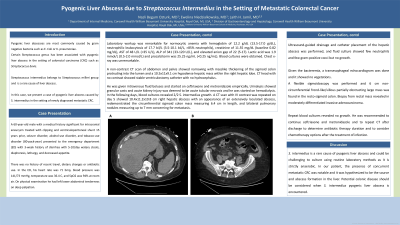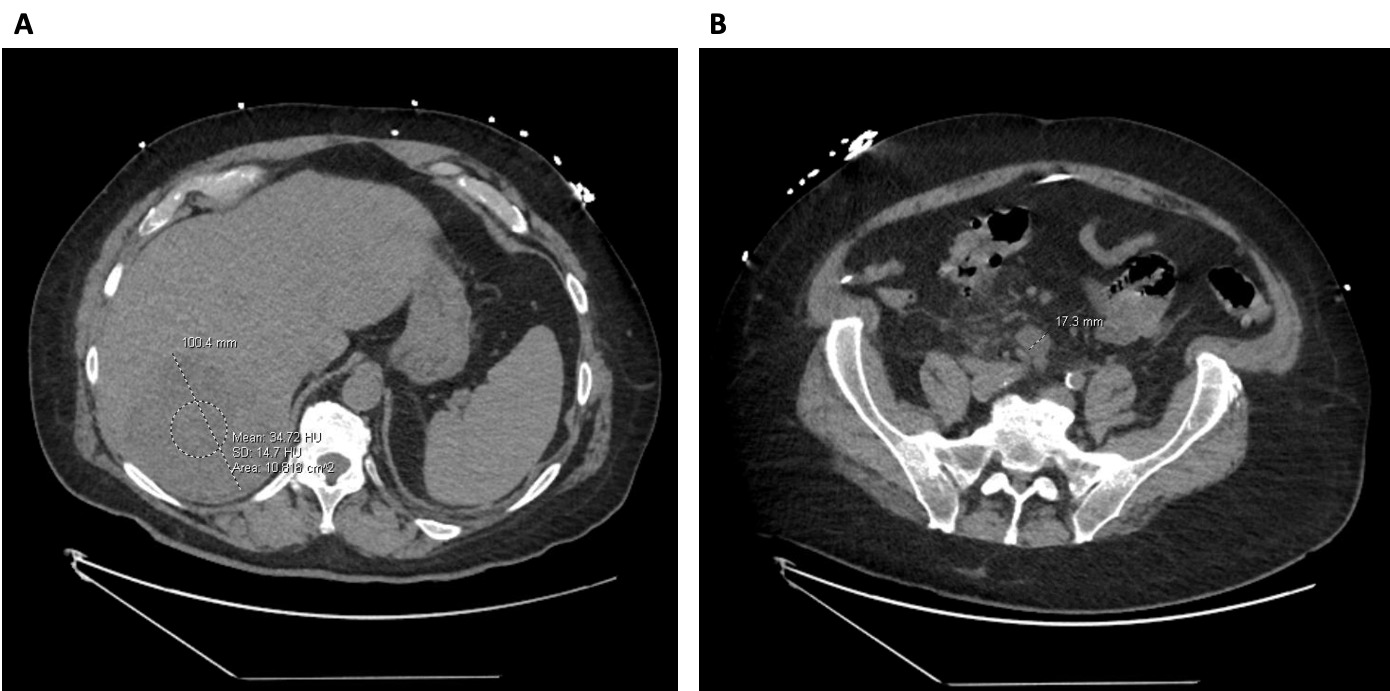Sunday Poster Session
Category: Liver
P1291 - Pyogenic Liver Abscess due to Streptococcus intermedius in the Setting of Metastatic Colorectal Cancer
Sunday, October 27, 2024
3:30 PM - 7:00 PM ET
Location: Exhibit Hall E

Has Audio
- NO
Nazli Begum Ozturk, MD
Corewell Health William Beaumont University Hospital
Royal Oak, MI
Presenting Author(s)
Nazli Begum Ozturk, MD1, Nathanial Bartosek, MD2, Ewelina Niedzialkowska, MD2, Laith H. Jamil, MD3
1Corewell Health William Beaumont University Hospital, Royal Oak, MI; 2Beaumont Health, Royal Oak, MI; 3Oakland University William Beaumont School of Medicine, Royal Oak, MI
Introduction: Streptococcus intermedius belongs to Streptococcus milleri group and is a rare cause of liver abscess. In this case, we present a case of pyogenic liver abscess caused by S. intermedius in the setting of newly diagnosed metastatic CRC.
Case Description/Methods: A 60-year-old male with a medical history significant for alcohol-use disorder presented to the emergency department (ED) with 3-week history of diarrhea with 5-10/day watery stools, diaphoresis, and lethargy. There was no history of recent travel, dietary changes or antibiotic use. On presentation he was afebrile, hemodynamically stable, and and on exam had left lower abdominal tenderness. Laboratory workup showed hemoglobin of 12.2 g/dL (13.5-17.0 g/dL), WBC of 17.7 bil/L (3.5-10.1 bil/L, >85% neutrophils), creatinine of 11.55 mg/dL (baseline 0.82 mg/dL), AST of 48 U/L (< 35 U/L), ALP of 341 (33-120 U/L). Lactic acid was 1.9 mmol/L (0.5-2.0 mmol/L) and procalcitonin was 25.25 ng/mL (< 0.25 ng/mL). Blood cultures were obtained. Chest x-ray was unremarkable. A non-contrast CT scan of abdomen and pelvis showed narrowing with masslike thickening of the sigmoid colon protruding into the lumen and a 10.5x11x9.1 cm hypodense hepatic mass within the right hepatic lobe. He was started on ceftriaxone and metronidazole empirically. Urinalysis showed granular casts and hemodialysis was initiated. Blood cultures revealed 2/2 S. intermedius growth. A CT scan of chest, abdomen, pelvis with IV contrast was repeated on day 5 showed 10.4x11.2x10.8 cm right hepatic abscess with an appearance of an extensively loculated abscess, redemonstrated the circumferential sigmoid colon mass measuring 6.4 cm in length, and bilateral pulmonary nodules measuring concerning for metastasis. Ultrasound-guided drainage of the hepatic abscess was performed, and fluid culture showed few neutrophils and few gram-positive cocci but no growth. Flexible sigmoidoscopy showed 6 cm non-circumferential frond-like/villous partially obstructing large mass in the recto-sigmoid colon and histology revealed moderately differentiated invasive adenocarcinoma. Repeat blood cultures revealed no growth. He was recommended to continue antibiotics and to repeat abdominal CT to determine treatment duration.
Discussion: S. intermedius is a rare cause of pyogenic liver abscess and could be challenging to culture using routine laboratory methods as it is strictly anaerobic. Potential colonic disease should be considered when S. intermedius pyogenic liver abscess is encountered.

Disclosures:
Nazli Begum Ozturk, MD1, Nathanial Bartosek, MD2, Ewelina Niedzialkowska, MD2, Laith H. Jamil, MD3. P1291 - Pyogenic Liver Abscess due to <i>Streptococcus intermedius</i> in the Setting of Metastatic Colorectal Cancer, ACG 2024 Annual Scientific Meeting Abstracts. Philadelphia, PA: American College of Gastroenterology.
1Corewell Health William Beaumont University Hospital, Royal Oak, MI; 2Beaumont Health, Royal Oak, MI; 3Oakland University William Beaumont School of Medicine, Royal Oak, MI
Introduction: Streptococcus intermedius belongs to Streptococcus milleri group and is a rare cause of liver abscess. In this case, we present a case of pyogenic liver abscess caused by S. intermedius in the setting of newly diagnosed metastatic CRC.
Case Description/Methods: A 60-year-old male with a medical history significant for alcohol-use disorder presented to the emergency department (ED) with 3-week history of diarrhea with 5-10/day watery stools, diaphoresis, and lethargy. There was no history of recent travel, dietary changes or antibiotic use. On presentation he was afebrile, hemodynamically stable, and and on exam had left lower abdominal tenderness. Laboratory workup showed hemoglobin of 12.2 g/dL (13.5-17.0 g/dL), WBC of 17.7 bil/L (3.5-10.1 bil/L, >85% neutrophils), creatinine of 11.55 mg/dL (baseline 0.82 mg/dL), AST of 48 U/L (< 35 U/L), ALP of 341 (33-120 U/L). Lactic acid was 1.9 mmol/L (0.5-2.0 mmol/L) and procalcitonin was 25.25 ng/mL (< 0.25 ng/mL). Blood cultures were obtained. Chest x-ray was unremarkable. A non-contrast CT scan of abdomen and pelvis showed narrowing with masslike thickening of the sigmoid colon protruding into the lumen and a 10.5x11x9.1 cm hypodense hepatic mass within the right hepatic lobe. He was started on ceftriaxone and metronidazole empirically. Urinalysis showed granular casts and hemodialysis was initiated. Blood cultures revealed 2/2 S. intermedius growth. A CT scan of chest, abdomen, pelvis with IV contrast was repeated on day 5 showed 10.4x11.2x10.8 cm right hepatic abscess with an appearance of an extensively loculated abscess, redemonstrated the circumferential sigmoid colon mass measuring 6.4 cm in length, and bilateral pulmonary nodules measuring concerning for metastasis. Ultrasound-guided drainage of the hepatic abscess was performed, and fluid culture showed few neutrophils and few gram-positive cocci but no growth. Flexible sigmoidoscopy showed 6 cm non-circumferential frond-like/villous partially obstructing large mass in the recto-sigmoid colon and histology revealed moderately differentiated invasive adenocarcinoma. Repeat blood cultures revealed no growth. He was recommended to continue antibiotics and to repeat abdominal CT to determine treatment duration.
Discussion: S. intermedius is a rare cause of pyogenic liver abscess and could be challenging to culture using routine laboratory methods as it is strictly anaerobic. Potential colonic disease should be considered when S. intermedius pyogenic liver abscess is encountered.

Figure: A: 10.5x11x9.1 cm hypodense hepatic mass within the right lobe. B: Masslike thickening of the sigmoid colon protruding into the lumen.
Disclosures:
Nazli Begum Ozturk indicated no relevant financial relationships.
Nathanial Bartosek indicated no relevant financial relationships.
Ewelina Niedzialkowska indicated no relevant financial relationships.
Laith Jamil indicated no relevant financial relationships.
Nazli Begum Ozturk, MD1, Nathanial Bartosek, MD2, Ewelina Niedzialkowska, MD2, Laith H. Jamil, MD3. P1291 - Pyogenic Liver Abscess due to <i>Streptococcus intermedius</i> in the Setting of Metastatic Colorectal Cancer, ACG 2024 Annual Scientific Meeting Abstracts. Philadelphia, PA: American College of Gastroenterology.
